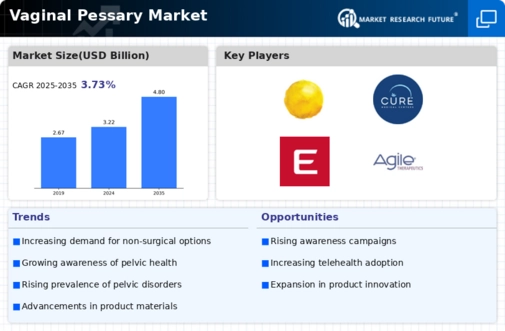Enhanced Product Awareness and Education
There is a notable increase in awareness and education surrounding women's health issues, particularly regarding pelvic floor disorders. This trend is likely to positively influence the Vaginal Pessary Market. Educational campaigns by healthcare organizations and advocacy groups are helping to demystify the use of vaginal pessaries, making them more acceptable to women. As women become more informed about their health options, the likelihood of seeking treatment increases. Reports suggest that educational initiatives have led to a 20% rise in consultations for pelvic floor disorders, which may correlate with a growing acceptance of vaginal pessaries as a viable treatment option. This heightened awareness is expected to drive the Vaginal Pessary Market forward, as more women recognize the benefits of these devices.
Technological Innovations in Pessary Design
Technological advancements in the design and materials used for vaginal pessaries are likely to propel the Vaginal Pessary Market. Innovations such as the development of softer, more flexible materials and customizable designs are enhancing user comfort and efficacy. Recent data indicates that the introduction of new designs has led to a 15% increase in user satisfaction rates. These improvements not only make vaginal pessaries more appealing but also encourage healthcare providers to recommend them more frequently. As manufacturers continue to invest in research and development, the market is expected to witness a surge in innovative products that cater to diverse patient needs, thereby expanding the Vaginal Pessary Market.
Increasing Prevalence of Pelvic Floor Disorders
The rising incidence of pelvic floor disorders, such as pelvic organ prolapse and urinary incontinence, appears to be a primary driver for the Vaginal Pessary Market. Studies indicate that approximately 30% of women experience some form of pelvic floor disorder during their lifetime. This growing prevalence necessitates effective management solutions, leading to an increased demand for vaginal pessaries. Healthcare providers are increasingly recommending these devices as a non-surgical option, which may contribute to their adoption. Furthermore, the aging population, particularly women over 50, is likely to exacerbate this trend, as the risk of pelvic floor disorders increases with age. Consequently, the Vaginal Pessary Market is expected to expand as more women seek treatment options that enhance their quality of life.
Rising Demand for Non-Surgical Treatment Options
The growing preference for non-surgical treatment options among women dealing with pelvic floor disorders is a crucial driver for the Vaginal Pessary Market. Many women are seeking alternatives to invasive surgical procedures due to concerns about recovery time, potential complications, and overall effectiveness. Data suggests that non-surgical options, including vaginal pessaries, are gaining traction, with a reported 25% increase in their usage over the past few years. This trend reflects a broader shift towards conservative management strategies in women's health. As awareness of the benefits of vaginal pessaries continues to spread, the Vaginal Pessary Market is poised for growth, catering to the needs of women who prefer less invasive treatment solutions.
Integration of Pessaries into Clinical Guidelines
The integration of vaginal pessaries into clinical practice guidelines is emerging as a significant driver for the Vaginal Pessary Market. As healthcare professionals increasingly recognize the benefits of non-surgical interventions for pelvic floor disorders, the recommendation of vaginal pessaries is becoming more common. Recent updates to clinical guidelines by various medical associations endorse the use of pessaries as a first-line treatment option. This endorsement is likely to enhance the credibility of vaginal pessaries among both patients and providers. Consequently, the Vaginal Pessary Market may experience growth as more healthcare facilities adopt these guidelines, leading to increased prescriptions and usage of vaginal pessaries.

















Leave a Comment